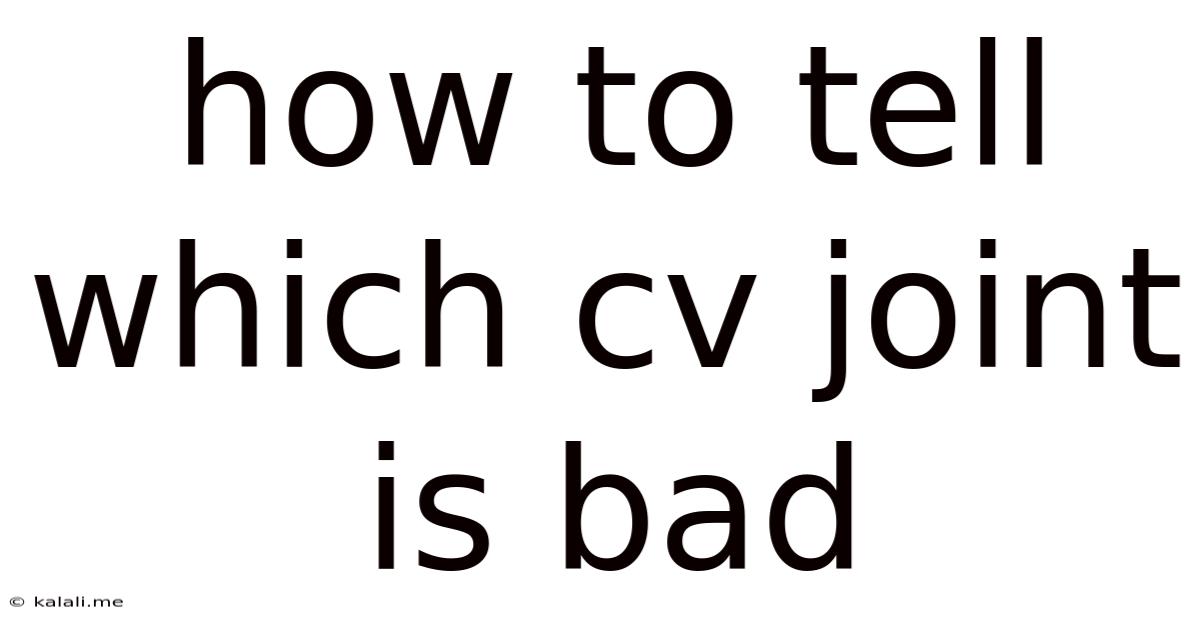How To Tell Which Cv Joint Is Bad
Kalali
Jun 09, 2025 · 3 min read

Table of Contents
How to Tell Which CV Joint is Bad: A Comprehensive Guide
Meta Description: Experiencing troubling vibrations, clicking noises, or a loss of control while driving? This guide helps you pinpoint a bad CV joint – front or rear – using simple checks and observations. Learn how to diagnose the problem yourself before heading to a mechanic.
Constant velocity (CV) joints are crucial components in your vehicle's drivetrain, enabling smooth power transfer to the wheels, especially during turns. A failing CV joint can lead to significant safety hazards and costly repairs. Knowing how to identify a bad CV joint early can save you time, money, and potentially a dangerous driving experience. This guide will walk you through the common signs of a bad CV joint, helping you determine whether it's the front or rear axle that needs attention.
Common Symptoms of a Bad CV Joint
Several noticeable symptoms indicate a failing CV joint. These symptoms can manifest gradually or suddenly, depending on the severity of the damage. Pay close attention to these warning signs:
-
Clicking or Popping Sounds: This is often the most prominent symptom. You'll hear clicking or popping noises, particularly when turning corners, accelerating, or decelerating. The sounds usually originate from the area of the affected wheel.
-
Vibration: A bad CV joint can cause vibrations that are felt in the steering wheel, floor, or even the entire car, especially at higher speeds or during turns. The vibration’s intensity often correlates with the speed of the vehicle and the sharpness of the turn.
-
Shaking or Wobble: A significant amount of play or looseness in the joint can cause noticeable shaking or wobbling in the affected wheel. This is a clear indication of significant damage.
-
Grease Leakage: CV joints are sealed units filled with grease. A damaged boot (the rubber covering protecting the joint) will often leak grease, leaving a telltale trail on the ground or on the suspension components. This is a major sign the joint itself is compromised and needs urgent replacement.
-
Uneven Tire Wear: Premature or irregular tire wear can sometimes be a symptom of a failing CV joint, as uneven power transfer to the wheel can lead to abnormal tire stress.
Identifying the Faulty Joint: Front vs. Rear
Determining whether the front or rear CV joint is at fault requires careful observation and testing.
Front Wheel Drive (FWD) Vehicles: In FWD vehicles, most of the wear and tear occurs in the front CV joints due to the constant torque transfer during acceleration and turning. Pay close attention to the sounds and vibrations originating from the front wheels. If you hear clicking when turning left, it could suggest the left front CV joint is failing, and vice-versa.
Rear Wheel Drive (RWD) Vehicles: RWD vehicles typically experience issues with the rear CV joints less frequently compared to their FWD counterparts. However, if your RWD vehicle is exhibiting the symptoms mentioned above, focus your attention on the rear axles. Listen carefully for the source of the clicking or popping sounds.
All-Wheel Drive (AWD) or Four-Wheel Drive (4WD) Vehicles: AWD/4WD systems are more complex. A faulty CV joint can be present on any wheel. The process of pinpointing the issue requires a more comprehensive inspection.
Visual Inspection
A visual inspection can further assist in diagnosing the faulty CV joint. Look closely at the CV joint boots for any signs of damage, such as cracks, tears, or grease leakage. A damaged boot is a strong indicator of an impending failure.
Professional Diagnosis
While these methods can help you identify a potential problem, a professional mechanic should perform a thorough diagnosis and repair. They have the specialized tools and expertise to confirm the diagnosis and replace the damaged joint correctly.
In summary: A bad CV joint is a serious concern that requires immediate attention. By understanding the common symptoms and following the steps outlined above, you can improve your chances of identifying the problem early and preventing further damage or accidents. Remember, safety should always be the top priority. If you are unsure, it's always best to consult a professional mechanic.
Latest Posts
Latest Posts
-
Somebody Once Told Me That The World Was Macaroni Lyrics
Jul 02, 2025
-
How Old Are You If Born In 1993
Jul 02, 2025
-
What Is 1 4 Of 1 4 Cup
Jul 02, 2025
-
Is Keri Russell Related To Kurt Russell
Jul 02, 2025
-
What Is Half Of 1 4 Teaspoon
Jul 02, 2025
Related Post
Thank you for visiting our website which covers about How To Tell Which Cv Joint Is Bad . We hope the information provided has been useful to you. Feel free to contact us if you have any questions or need further assistance. See you next time and don't miss to bookmark.